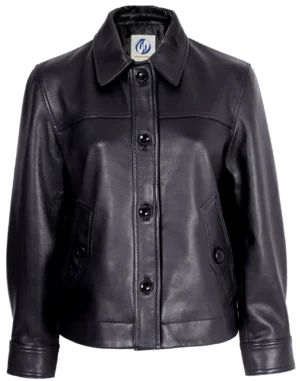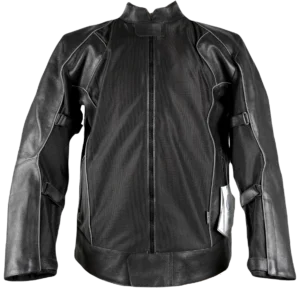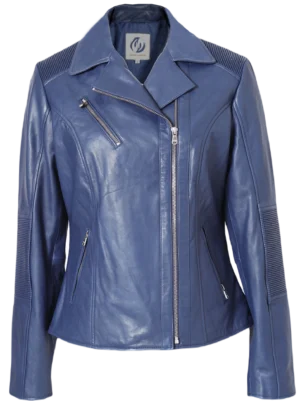When were leather Jackets invented?
The story of leather jackets traces back millennia to when our prehistoric ancestors first used animal hides for protection. However, the modern leather jacket as we know it today has much more recent origins, rooted in military necessity and innovation.
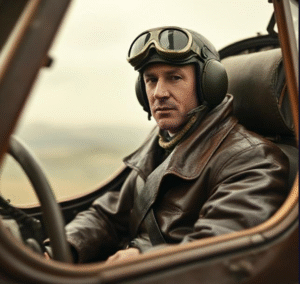 While many cultures developed leather armor and protective wear throughout history, the modern leather jacket emerged during World War I, when most airplanes had open cockpits and pilots needed protection from harsh conditions. The Royal Flying Corps pilots serving in France and Belgium began wearing long leather coats as early as 1915. The U.S. Army officially established the Aviation Clothing Board in September 1917 and began distributing heavy-duty leather flight jackets featuring high wraparound collars, zipper closures with wind flaps, snug cuffs and waists, with some fringed and lined with fur.
While many cultures developed leather armor and protective wear throughout history, the modern leather jacket emerged during World War I, when most airplanes had open cockpits and pilots needed protection from harsh conditions. The Royal Flying Corps pilots serving in France and Belgium began wearing long leather coats as early as 1915. The U.S. Army officially established the Aviation Clothing Board in September 1917 and began distributing heavy-duty leather flight jackets featuring high wraparound collars, zipper closures with wind flaps, snug cuffs and waists, with some fringed and lined with fur.
Leslie Irvin, a stuntman, first designed and manufactured the classic sheepskin flying jacket in 1926. He set up a manufacturing company in the United Kingdom and became the main supplier of flying jackets to the Royal Air Force during most of World War II. The first standardized flight jacket, the Type A-1, was produced in 1927 and featured a button-front design with knitted cuffs and a waistband, establishing the template for what we recognize today as a leather jacket.
When were Leather Jackets Popular?
Early 1900s
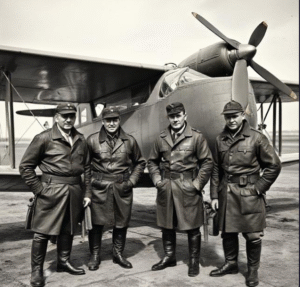 The early pilots didn’t discover “wind chill,” but the speeds of even early airplanes gave a full demonstration of its effects. Prior to modern synthetic fabrics, leather was the only flexible, wearable material that wind couldn’t penetrate. These early bomber jackets were purely functional, designed for survival in freezing high-altitude conditions rather than fashion.
The early pilots didn’t discover “wind chill,” but the speeds of even early airplanes gave a full demonstration of its effects. Prior to modern synthetic fabrics, leather was the only flexible, wearable material that wind couldn’t penetrate. These early bomber jackets were purely functional, designed for survival in freezing high-altitude conditions rather than fashion.
1928
In 1928, Irving Schott designed the first motorcycle jacket, which he named the “Perfecto” after his favorite shape of cigar. Made from heavy-grade horsehide with wool lining and featuring an innovative asymmetrical zipper, it was sold through a Harley-Davidson dealer on Long Island for $5.50. The asymmetrical zipper was a practical innovation that prevented wind from penetrating the jacket while riders were hunched over their motorcycles, and it also avoided uncomfortable pressure on the rider’s sternum when leaning forward.
1930s-1940s
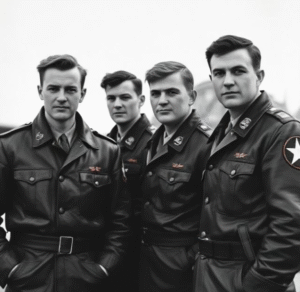 The A-2 Flight Jacket arrived in the early 1930s and became standard issue for the Air Corps. First made from “seal brown” horsehide leather with a silk lining, it featured a front zipper and shirt-style collar. As aerospace technology improved and aircraft operated at higher altitudes, some heavy bombing raids in Europe during World War II took place from at least 25,000 feet, where ambient temperatures could reach as cold as -50°C (-58°F)—warm, thick flight jackets became essential equipment for every crew member.
The A-2 Flight Jacket arrived in the early 1930s and became standard issue for the Air Corps. First made from “seal brown” horsehide leather with a silk lining, it featured a front zipper and shirt-style collar. As aerospace technology improved and aircraft operated at higher altitudes, some heavy bombing raids in Europe during World War II took place from at least 25,000 feet, where ambient temperatures could reach as cold as -50°C (-58°F)—warm, thick flight jackets became essential equipment for every crew member.
In addition to the A-2 and G-1 jackets, shearling jackets lined with fur were recognized as the warmest flight jackets. This warmth enabled Lt. John A. Macready to set a world record in April 1921, reaching an altitude of 40,000 feet in his open-cockpit airplane.
1950s
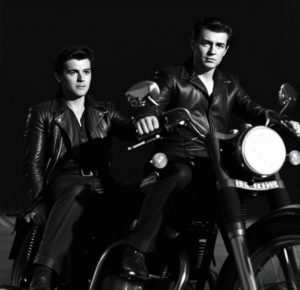 The 1950s marked the transformation of leather jackets from practical military and motorcycle gear into powerful cultural symbols. When Marlon Brando wore a Perfecto-style jacket (model 618) in “The Wild One” (1953), the leather jacket became emblematic of rebellion and was banned by many American schools because it symbolized the burgeoning “hoodlum” teen demographic. Just one year later, in 1955, James Dean, who was rarely seen without his Perfecto, further cemented this status in “Rebel Without a Cause.” When Dean died in a car accident that year, sales of the Perfecto skyrocketed.
The 1950s marked the transformation of leather jackets from practical military and motorcycle gear into powerful cultural symbols. When Marlon Brando wore a Perfecto-style jacket (model 618) in “The Wild One” (1953), the leather jacket became emblematic of rebellion and was banned by many American schools because it symbolized the burgeoning “hoodlum” teen demographic. Just one year later, in 1955, James Dean, who was rarely seen without his Perfecto, further cemented this status in “Rebel Without a Cause.” When Dean died in a car accident that year, sales of the Perfecto skyrocketed.
This adoption coincided with post-war youth culture seeking symbols of independence and rejection of conventional values. The durability of leather also represented permanence in an increasingly disposable consumer culture.
1960s
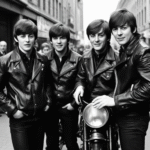 During the 1960s, leather jackets were adopted by counterculture movements and rock musicians. The Beatles famously wore leather during their early Hamburg days, while motorcycle clubs embraced the garment as an unofficial uniform. This period saw leather jackets represent artistic rebellion and community identity, with specific styles signaling group affiliation.
During the 1960s, leather jackets were adopted by counterculture movements and rock musicians. The Beatles famously wore leather during their early Hamburg days, while motorcycle clubs embraced the garment as an unofficial uniform. This period saw leather jackets represent artistic rebellion and community identity, with specific styles signaling group affiliation.
1970s-1980s
 In 1974, a new underground music scene emerged at CBGB in downtown New York City. The Ramones, wearing Schott Perfecto black leather jackets as their signature uniform, established the leather jacket as the symbol of punk rock. The band members adopted a uniform look of long hair, leather jackets, T-shirts, torn jeans, and sneakers. This fashion emphasized minimalism and became a powerful influence on the New York punk scene of the 1970s.
In 1974, a new underground music scene emerged at CBGB in downtown New York City. The Ramones, wearing Schott Perfecto black leather jackets as their signature uniform, established the leather jacket as the symbol of punk rock. The band members adopted a uniform look of long hair, leather jackets, T-shirts, torn jeans, and sneakers. This fashion emphasized minimalism and became a powerful influence on the New York punk scene of the 1970s.
Bruce Springsteen wore a Schott Perfecto on the cover of his “Born to Run” album in 1975, becoming an icon for middle-class working families of America. The 1980s saw leather jackets enter mainstream fashion, with movies like “Top Gun” revitalizing interest in bomber styles and Michael Jackson popularizing the red leather jacket in his “Thriller” video (1983).
1990s-2000s
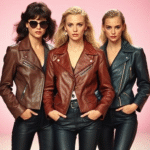 The 1990s saw leather jackets become high fashion staples, with designers crafting luxury leather jacket versions that added prestige to the garment’s rebellious heritage. In the 2000s, vintage and distressed leather looks gained popularity as fashion embraced authenticity. The resurgence reflected growing interest in sustainable consumption and appreciation for garments with history and character.
The 1990s saw leather jackets become high fashion staples, with designers crafting luxury leather jacket versions that added prestige to the garment’s rebellious heritage. In the 2000s, vintage and distressed leather looks gained popularity as fashion embraced authenticity. The resurgence reflected growing interest in sustainable consumption and appreciation for garments with history and character.
Today
 Today, leather jackets remain timeless. Sustainable alternatives using vegan leather have emerged to address ethical concerns, while vintage hunting for authentic mid-century jackets has become popular among collectors and fashion enthusiasts. Modern leather jackets blend technological innovations in tanning and construction with respectful nods to heritage designs.
Today, leather jackets remain timeless. Sustainable alternatives using vegan leather have emerged to address ethical concerns, while vintage hunting for authentic mid-century jackets has become popular among collectors and fashion enthusiasts. Modern leather jackets blend technological innovations in tanning and construction with respectful nods to heritage designs.
WHAT IS FULL-GRAIN LEATHER
Full-grain sheepskin leather is the highest quality, with an unaltered top layer that offers unmatched durability and authentic character. Unlike heavily processed ‘Genuine Leather’ used by most manufacturers, this premium piece delivers genuine luxury at an exceptional price. Check out Mayim Leathers’ full-grain jackets.
What Does a Leather Jacket Symbolize?
Power and Strength
Throughout history, the leather jacket has symbolized toughness, rebellion, and nonconformity. Wearers, from military pilots to motorcycle gangs to rock stars, have used leather jackets to project confidence and strength. The material communicates durability and protection, creating an immediate visual association with resilience.
A Statement of Timeless Fashion
Beyond rebellion, leather jackets represent timeless style. Few garments have maintained relevance across a century of changing fashion, making them powerful symbols of enduring design. The leather jacket’s ability to adapt to different cultural contexts while retaining its essential character makes it unique in fashion history.
Different Styles of Leather Jackets
Bomber Leather Jackets
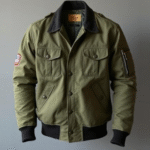 Originating from military flight jackets, bomber jackets feature elastic waistbands and cuffs with a front zipper and roomy fit designed for layering. This design evolved specifically for pilots who needed warmth without bulk and easy access to flight instruments, which explains its functional blouson shape and practical pocket placements. The design allows for freedom of movement while providing protection against wind and cold.
Originating from military flight jackets, bomber jackets feature elastic waistbands and cuffs with a front zipper and roomy fit designed for layering. This design evolved specifically for pilots who needed warmth without bulk and easy access to flight instruments, which explains its functional blouson shape and practical pocket placements. The design allows for freedom of movement while providing protection against wind and cold.
Cafe Racer Leather Jackets
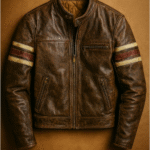 Minimalist and sleek cafe racers emerged from 1960s motorcycle culture, featuring a straight zipper, mandarin collar, and streamlined profile. These jackets were designed for forward-leaning riding positions on sports motorcycles, with their streamlined silhouette reducing wind resistance during high-speed races between cafes in European cities.
Minimalist and sleek cafe racers emerged from 1960s motorcycle culture, featuring a straight zipper, mandarin collar, and streamlined profile. These jackets were designed for forward-leaning riding positions on sports motorcycles, with their streamlined silhouette reducing wind resistance during high-speed races between cafes in European cities.
Aviator Leather Jackets
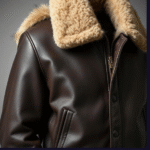 Distinguished by their shearling lining and oversized collars, aviator jackets were designed for high-altitude protection for World War II pilots. The shearling jackets provided critical insulation at freezing heights, while the large collar could be turned up to protect the neck and face during extreme conditions in unpressurized aircraft.
Distinguished by their shearling lining and oversized collars, aviator jackets were designed for high-altitude protection for World War II pilots. The shearling jackets provided critical insulation at freezing heights, while the large collar could be turned up to protect the neck and face during extreme conditions in unpressurized aircraft.
Biker Leather Jackets
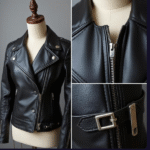 The Biker Leather jackets have a classic asymmetrical design with wide lapels, zippered pockets, and a belted waist derived from Schott’s original Perfecto, designed to protect motorcyclists. The offset zipper prevented uncomfortable pressure on the rider’s sternum when leaning forward, while the snapped lapels could be secured to prevent flapping at high speeds. Multiple pockets served practical purposes for riders carrying tools and personal items.
The Biker Leather jackets have a classic asymmetrical design with wide lapels, zippered pockets, and a belted waist derived from Schott’s original Perfecto, designed to protect motorcyclists. The offset zipper prevented uncomfortable pressure on the rider’s sternum when leaning forward, while the snapped lapels could be secured to prevent flapping at high speeds. Multiple pockets served practical purposes for riders carrying tools and personal items.
Why Full-Grain for Leather Jackets?
Full-grain leather is the hide’s strongest, untouched layer. It breathes better, resists wear, and improves with age, developing rich patina. While cheaper leather cracks, full-grain becomes more beautiful—a lifetime investment.
FAQs
Were Leather Jackets Popular in the 90s?
Yes, leather jackets were immensely popular in the 1990s, appearing in grunge scenes and as high-fashion items. The decade’s interest in vintage Americana and industrial aesthetics made leather jackets particularly relevant, while designers like Versace and Gucci elevated the garment to luxury status.
When Did the Leather Jacket Become an Icon?
The leather jacket achieved iconic status in the 1950s through Hollywood’s influence, particularly Marlon Brando’s and James Dean’s portrayals. These films coincided with America’s fascination with youth culture and rebellion, creating the perfect cultural moment for the leather jacket to transcend its utilitarian origins.
Which Was the First Profession to Wear Leather Jackets?
Military aviators were the first profession to widely adopt leather jackets as standard equipment during World War I. The extreme conditions of early flight—open cockpits, high altitudes, and freezing temperatures—necessitated protective gear that traditional military uniforms couldn’t provide.
Conclusion
From military necessity during World War I to rebellious statement in the 1950s to fashion staple today, the leather jacket has evolved while maintaining its core appeal. Its ability to simultaneously represent protection, rebellion, and style has ensured its place as one of fashion’s most enduring garments, continually reinventing itself while honoring its rich heritage.
What makes the leather jacket remarkable is how its functional origins inform its aesthetic appeal—each design element exists for a specific reason, creating a perfect marriage of form and function that few garments can match. Whether it’s the asymmetrical zipper on a biker jacket preventing wind penetration, the shearling lining on an aviator jacket providing warmth at 25,000 feet, or the streamlined cut of a cafe racer reducing wind resistance, every detail serves a purpose born from real-world needs.
Today’s leather jacket wearers inherit this legacy, whether they’re aware of it or not. Each time someone puts on a leather jacket, they’re connecting with nearly a century of aviation heroes, rebellious youth, rock legends, and style icons who chose this garment to express who they are.
References
- Wikipedia Contributors. “Flight jacket.” Wikipedia, The Free Encyclopedia. Accessed October 2025. https://en.wikipedia.org/wiki/Flight_jacket
- Flying Wolf Collection. “Bomber & Flight Vintage Leather Jackets.” Flying Wolf. Accessed October 2025. https://lastwolf.us/collections/flying-wolf
- History Preservation. “WWI Imperial German Aviator Flying Coat.” History Preservation. June 2, 2025. https://www.historypreservation.com/products-page/brands/german-wwi-imperial-aviator-leather-flying-coat/
- Lastwolf. “History of the Flight Jacket.” Lastwolf Blog. December 4, 2021. https://lastwolf.us/blogs/journey/history-of-the-flight-jacket
- Maker of Jacket. “The Complete History of Leather Jackets for 2025.” Maker of Jacket. August 5, 2025. https://www.makerofjacket.com/history-of-leather-jackets/
- Bowers Fly Baby. “Leather Jackets for the Open-Cockpit Aviator.” Bowers Fly Baby Stories. Accessed October 2025. http://www.bowersflybaby.com/stories/jackets.html
- Heddels. “The History of Flight Jackets From 1927 to 1946.” Heddels. November 27, 2017. https://www.heddels.com/2017/11/american-flight-jackets-from-1927-to-1950-the-complete-guide-2/
- Smithsonian National Air and Space Museum. “Leather Coat, World War I, Rickenbacker.” National Air and Space Museum Collection. Accessed October 2025. https://airandspace.si.edu/collection-objects/leather-coat-world-war-i-rickenbacker/nasm_A19530062000
- Vintage Leder. “Flight Leather Jackets.” Vintage Leder Online Store. Accessed October 2025. https://vintage-leder.com/collections/flight-leather-jackets
- Military Wiki. “Flight jacket.” Military Wiki, Fandom. Accessed October 2025. https://military-history.fandom.com/wiki/Flight_jacket
- Schott NYC. “The Perfecto Motorcycle Jacket Timeline: History of an Icon.” Schott NYC Official Website. Accessed October 2025. https://www.schottnyc.com/perfectotimeline
- Wikipedia Contributors. “Perfecto motorcycle jacket.” Wikipedia, The Free Encyclopedia. January 11, 2025. https://en.wikipedia.org/wiki/Perfecto_motorcycle_jacket
- Heddels. “The Perfecto Perfected – A History Of The Asymmetrical Leather Jacket.” Heddels. May 9, 2018. https://www.heddels.com/2017/12/perfecto-perfected-history-asymmetrical-leather-jacket/
- Gentleman’s Gazette. “Schott Perfecto Motorcycle Jacket: Is It Worth It? (Review).” Gentleman’s Gazette. October 29, 2021. https://www.gentlemansgazette.com/schott-perfecto-motorcycle-jacket-2/
- Wikipedia Contributors. “Schott NYC.” Wikipedia, The Free Encyclopedia. June 22, 2025. https://en.wikipedia.org/wiki/Schott_NYC
- Franklin & Poe. “Schott NYC.” Franklin & Poe Collections. Accessed October 2025. https://franklinandpoe.com/collections/schott-nyc
- Schott NYC. “History of Schott NYC.” Schott NYC Official Website. Accessed October 2025. https://www.schottnyc.com/about.cfm
- Schott Store. “The Perfecto Jacket.” Schott Store. Accessed October 2025. https://www.schott-store.com/en/pages/the-perfecto-1
- Uncrate Supply. “Schott NYC Perfecto Motorcycle Jacket.” Uncrate Supply. Accessed October 2025. https://shop.uncrate.com/products/schott-nyc-motorcycle-jacket
- Schott NYC. “Limited Edition 90th Anniversary Perfecto Jacket.” Schott NYC Official Website. Accessed October 2025. https://www.schottnyc.com/per90
- Wikipedia Contributors. “Ramones.” Wikipedia, The Free Encyclopedia. October 2025. https://en.wikipedia.org/wiki/Ramones
- Denim Dudes. “The Surprising Homoerotic Roots of The Ramone’s Style.” Denim Dudes. Accessed October 2025. https://denimdudes.co/the-surprising-homoerotiv-roots-of-the-ramones-style/
- AnOther Magazine. “Johnny Ramone: All-American Punk Icon.” AnOther. February 2, 2012. https://www.anothermag.com/fashion-beauty/1727/johnny-ramone-all-american-punk-icon
- Wikipedia Contributors. “Punk fashion.” Wikipedia, The Free Encyclopedia. February 5, 2025. https://en.wikipedia.org/wiki/Punk_jacket
- Schott NYC Forum. “Did the Ramones wear Perfecto jackets?” Schott NYC Forum. Accessed October 2025. https://www.schottnyc.com/forum/posts/ramones.htm
- Punk Rock Blog. “The Uniform of the Ramones: A Punk Fashion Icon.” punkrock.blog. November 11, 2023. https://punkrock.blog/2023/11/10/the-uniform-of-the-ramones-a-punk-fashion-icon/
- RR Auction. “Dee Dee Ramone Stage-Worn Schott Leather Jacket.” RR Auction. Accessed October 2025. https://www.rrauction.com/auctions/lot-detail/347561406673397-dee-dee-ramone-stage-worn-schott-leather-jacket/
Additional Reading:
- National WWII Museum – For comprehensive information on military leather jackets and their role in World War II
- Smithsonian Institution Archives – Historical documentation of early aviation clothing and equipment
- Fashion History Timeline – For context on how leather jackets evolved within broader fashion movements
Note: All references were accessed and verified in October 2025. Some sources may require direct navigation as URLs can change over time.





